Features
By: Mikio Moriyasu - Revised: 2006-07-03 devinIntroduction
It seems as if everyone out there is marketing some kind of USB Flash Drive. A quick Google Search reveals dozens of sites for manufacturers and retailers. Look closer at these sites and you will encounter a dizzying variety of different case designs, physical sizes, capacities, features, colors, and (believe it or not) accessories. There are USB Flash Drive pens, USB Flash Drive wrist watches, and even a USB Flash Drive Swiss Army Knife.
Meritline SpyPen Drive | Meritline Flash Drive Watches | Victorinox/Swissbit SWISSMEMORY®
When you look past all of the bells and whistles, however, there are only a handful of significant features that define these devices. You should examine each one when considering which available USB Flash Drive is best suited for your needs.
Section Links

Currently, all USB Flash Drives are equipped with either a USB 1.1 or USB 2.0 connector interface. The primary difference between the two is the overall rate of data transfer. USB 1.1 has a rate of 12 Megabits per second while USB 2.0 is significantly faster at 480 Megabits per second.
The difference in data transfer rates can result in compatibility issues between the two standards. Because USB 2.0 devices require the higher bandwidth for operation, when they are plugged into USB 1.1 ports, the 12 Mb/sec limit is not enough for them to function. As a general rule, USB 2.0 devices are limited for use on USB 2.0 ports only. This is not the case, however, when USB 1.1 devices are plugged into USB 2.0 ports. The 480 Mb/sec limit for USB 2.0 is more than able to meet the 12 Mb/sec requirements of USB 1.1. As a result, USB 1.1 devices can be used with USB 2.0 ports in addition to USB 1.1 ports.
Because the data transfer rate requirements are built into the two USB standards, any related compatibility issues are independent of the operating system. It really all depends on what type of USB ports you have on your Mac.
Compatibility
USB Flash Drives manufacturers specifications indicate that their drives will function with the latest Mac or Windows operating systems right out of the box.There are some drives, however, will have compatibility issues with older file systems including Windows 98, and Mac OS 8.x. Manufacturers of these units generally supply downloadable drivers for these operating systems. In addition, certain built-in or preprogrammed features of USB Flash Drives such as password protection may be only available when the drive is used on certain platforms or with certain operating systems. Unfortunately, the only available solution is to know this before purchasing the flash drive.
As is the case when purchasing any third-party hardware, when buying a USB Flash Drive, doing in-depth research ahead of time is always beneficial. You should check the available independent and manufacturer's documentation to make sure that your primary hardware, and operating system will function with your chosen drive. Similar research should also be made with regards to disk maintenance and utility applications. It would not be good to find out after attempting to erase or reformat a USB Flash Drive that the application has corrupted the device.

The majority of all USB Flash Drives are about the size and weight of a pack of chewing gum. The exact size will vary from model to model, manufacturer to manufacturer, and if there are any specific design features. A few companies, such as Iomega, have produced a drive so small that the drive hardware is only slightly larger than the USB plug.
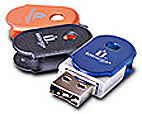
The inherent portability of these drives prompts most manufacturers to include some kind of carry accessory such as a case with a clip, a key ring, or detachable lanyard.
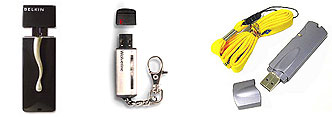
Expandibility
This is a new feature for what is a relative new product. A small number of manufacturers are starting to produce USB Flash Drives that are expandable and can be upgraded by simply snapping on a separate memory module or inserting a compact flash memory card into a built-in reader/encoder slot.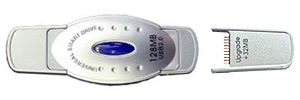
K&C Technologies Universal Smart Drive
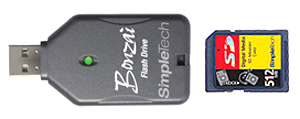
SimpleTech Bonzai Upgradable USB Flash Drive
While the current crop of modular drives feature simple memory upgrades or cosmetic accessories, the potential is significant. A simple, base model drive could be expanded to many times it's capacity and equipped with security features. As new interface technologies are developed, the drive's old USB connector could be swapped out with the newest, fastest design.
Durability
Externally, the most obvious feature of most USB Flash Drives is the hard plastic case. While admittedly some cases appear more robust than others, in general, USB Flash Drives are more resistant to physical damage than CD/DVD media, floppies, and Zip Disks. The case along with the drives' compact size and virtually no moving internal parts make them less likely to be adversely affected by being dropped or stepped on. They are not indestructible, however, and repeated abuse will take its toll over time.Internally, USB Flash Drives store data electronically on nonvolatile flash memory rather than on more volatile magnetic media. Data stored on Flash Drives, is not affected by environmental magnetic fields, moderate temperature, and standard airport x-ray machines. The drives are also water resistant and can be used again but only after they have been thoroughly dried so they do not short out when plugged in. As with physical trauma, however, operation of USB Flash Drives in extreme conditions should not be attempted.
Under normal operating conditions, however, data stored on the drive is relatively safe. According to one estimate, under optimum conditions a USB Flash Drive can store data without degradation for up to ten years.
Capacity
USB Flash Drives are manufactured in the following standard capacities:- 16MB: 20 - 30 (Avg Price Range in US dollars)
- 32 MB: 20 - 30
- 64 MB: 25 - 50
- 128 MB: 40 - 60
- 256 MB: 70 - 90
- 512 MB: 140 - 200
- 1 GB: 280 - 310
- 2 GB: 540 - 850
The exact cost varies from vendor to vendor and the prices listed above are an average value for each capacity. The high price for the large capacity drives can be attributed to both their relative newness and their available storage space. Their cost should come down over time as newer, still larger drives are introduced. It would not be surprising to see the 16, and 32 MB drives become discontinued at the same time.
Security
Depending on your occupation and the kinds of files you work with, you may be concerned about securing your USB Flash Drive from unauthorized access.
Read/Write Protection toggle switch | Thumbdrive Secure w/ Password protection
Some drives feature a physical switch that toggles read/write protection similar to that offered by floppy and Zip disks. Others offer basic password protection that preprogrammed into the drive at the factory or can be set up by the user with bundled software.

Kanguru MicroDrive w/ 32 bit encryption | PicoDisk Crypt w/ 128 bit AES encryption
Still others feature built-in encryption protocols that encrypts all files saved to the drive. Complete access is only allowed after the owner has entered a PIN. Certain flash drives feature 128 bit AES (Advanced Encryption Standard) encryption. This is a symmetric-key algorithm adopted by the National Institute of Standards and Technology (NIST) as a standard for government and private use to protect sensitive, nonclassified data. It enables very fast and highly secure encryption and decryption of data. Because it is a symmetric-key algorithm, keys are stored securely on the user's computer.
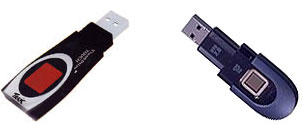
ThumbDrive Touch | Sony MicroVault
A few manufacturers have gone one step further by equipping their drives with a biometric security device such as a fingerprint scanner. These devices basically use recognition software to scan and compare a user's fingerprint against a stored template. If the two match the user is granted access to the drive's contents.
Read/write and basic password protection can be found on drives of all capacities. The encryption features and biometric devices are generally available on the 16 to 512 MB capacity drives. These sizes are more likely to be purchased by professionals who require a certain level of security. More thorough security, however, adds to the overall cost of the drive. Encryption roughly doubles the cost of the base drive while a biometric device triples it. The high cost of 1 and 2 GB drives makes the addition of security beyond a basic password not practical at this time.
If the cost of additional security is too great, if you already have a USB Flash Drive that has no security features, if the installed security feature has platform-based limitations, or if you want an additional level of protection, Mac OS X offers another alternative.
Multiple Functions
While originally designed for data storage, manufacturers are introducing USB Flash Drive that can perform a number of different functions.The most widely available alternate function is as an MP3 player. At a cost that is two to three times more than a basic drive, MP3 player drives generally come with stereo headphones, built-in controls, automatic power-off, and a built in power cell that recharges each time the drive is plugged in. A few models come with an LCD display that shows the track number and the time remaining, a digital voice recorder, and an FM radio.

Philips Audio Key Ring with 5-button remote | GoBeyond with Digital Voice Recorder, & FM radio
Philips even has a rechargeable 64 MB flash drive that is equipped with a built-in 1.3 magpie digital camera.

Philips Camera Key Ring
- Documentation
- Administration
- Authentication
- General Software
- Hardware
- Miscellaneous
- Multimedia
- Networking
- Operating Systems
- Outside Presentations
- Programming & Scripting
- Security
- Servers
- Short Courses
- System Deployment
- System Utilities
- What's New

